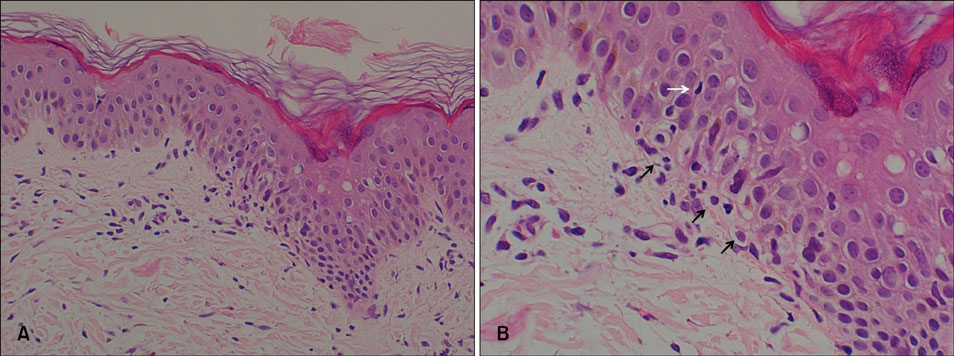Ann Dermatol.
2011 Aug;23(3):382-385. 10.5021/ad.2011.23.3.382.
Neonatal Erythema Multiforme: A Case Report
- Affiliations
-
- 1Department of Dermatology, Seoul National University College of Medicine, Seoul, Korea. daehun@snu.ac.kr
- 2Chois Skin Clinic, Seoul, Korea.
- KMID: 2171935
- DOI: http://doi.org/10.5021/ad.2011.23.3.382
Abstract
- Erythema multiforme (EM) is an extremely rare condition in infancy. To the best of our knowledge, there have been only three cases of neonatal EM described in the literature, and no such cases have been reported in Korea. A preterm neonate born at 35 weeks and six days of gestation presented with multiple annular erythematous patches with a targetoid shape over his entire body at 36 days of age (corrected age of 7 days). He had no systemic symptoms except for transient mild fever. No triggering factor except for hepatitis B and BCG vaccination was found. Neutropenia was noted upon laboratory analysis. Skin biopsy specimens showed findings suggestive of erythema multiforme. The skin lesions improved rapidly upon administration of intravenous methylprednisolone; however, neutropenia continued for a much longer period. The significance of neutropenia with respect to the development of EM was not clarified. There has been no recurrence of skin lesions over a one-year follow-up period.
Keyword
MeSH Terms
Figure
Reference
-
1. Huff JC, Weston WL, Tonnesen MG. Erythema multiforme: a critical review of characteristics, diagnostic criteria, and causes. J Am Acad Dermatol. 1983. 8:763–775.
Article2. Edmond BJ, Huff JC, Weston WL. Erythema multiforme. Pediatr Clin North Am. 1983. 30:631–640.
Article3. Weston WL, Morelli JG. Herpes simplex virus-associated erythema multiforme in prepubertal children. Arch Pediatr Adolesc Med. 1997. 151:1014–1016.
Article4. Brice SL, Huff JC, Weston WL. Erythema multiforme. Curr Probl Dermatol. 1990. 2:5–25.
Article5. Dikland WJ, Oranje AP, Stolz E, van Joost T. Erythema multiforme in childhood and early infancy. Pediatr Dermatol. 1986. 3:135–139.
Article6. Johnston GA, Ghura HS, Carter E, Graham-Brown RA. Neonatal erythema multiforme major. Clin Exp Dermatol. 2002. 27:661–664.
Article7. Torrelo A, Moreno M, Prada I, Celma ML, Zambrano A. Erythema multiforme in a neonate. J Am Acad Dermatol. 2003. 48:5 Suppl. S78–S79.
Article8. Custer JW, Rau RE, Lee CK. The harriet lane handbook. 2008. 18th ed. Philadelphia: Mosby;360.9. Ashkenazi S, Metzker A, Rachmel A, Nitzan M. Erythema multiforme as a single manifestation of cow's milk intolerance. Acta Paediatr. 1992. 81:729–730.
Article10. Nanda S, Pandhi D, Reddy BS. Erythema multiforme in a 9-day-old neonate. Pediatr Dermatol. 2003. 20:454–455.
Article11. Wine E, Ballin A, Dalal I. Infantile erythema multiforme following hepatitis B vaccine. Acta Paediatr. 2006. 95:890–891.
Article12. Korting HC, Vieluf D. Erythema multiforme and dermatitis seborrhoides infantum as concomitant id-reactions to widespread candidosis in a suckling. Mycoses. 1991. 34:415–417.
Article13. Kliegman RM, Behrman RE, Jenson HB, Stanton BF. Nelson textbook of pediatrics. 2007. 18th ed. Philadelphia: WB Saunders;2744.14. Dostrovsky A, Sagher F. Dermatological complications of BCG vaccination. Br J Dermatol. 1963. 75:181–192.15. Dogliotti M. Erythema multiforme--an unusual reaction to BCG vaccination. S Afr Med J. 1980. 57:332–334.16. Tschen EH, Jessen RT, Robertson G, Becker LE. Erythema multiforme as a complication of BCG scarification technique. Arch Dermatol. 1979. 115:614–615.
Article17. Baley JE, Stork EK, Warkentin PI, Shurin SB. Neonatal neutropenia. Clinical manifestations, cause, and outcome. Am J Dis Child. 1988. 142:1161–1166.18. Funke A, Berner R, Traichel B, Schmeisser D, Leititis JU, Niemeyer CM. Frequency, natural course, and outcome of neonatal neutropenia. Pediatrics. 2000. 106:45–51.
Article19. James RM, Kinsey SE. The investigation and management of chronic neutropenia in children. Arch Dis Child. 2006. 91:852–858.
Article20. Weston WL. Steroids in erythema multiforme (EM). Pediatr Dermatol. 2000. 17:75–83.
Article21. Prendiville JS. Erythema multiforme and steroids. Pediatr Dermatol. 2000. 17:75–83.
Article22. Renfro L, Grant-Kels JM, Feder HM Jr, Daman LA. Controversy: are systemic steroids indicated in the treatment of erythema multiforme? Pediatr Dermatol. 1989. 6:43–50.
Article23. Rasmussen JE. Erythema multiforme in children. Response to treatment with systemic corticosteroids. Br J Dermatol. 1976. 95:181–186.
- Full Text Links
- Actions
-
Cited
- CITED
-
- Close
- Share
- Similar articles
-
- Four Cases of Herpes - Associated Erythema Multiforme
- Recognizable koebner phemohomena in erythema multiforme:Report of Five cases
- A Case of Erythema Multiforme in Adults Associated with Mycoplasma pneumoniae Infection
- Erythema Multiforme like Bullous Pemphigoid
- Histopathologic Study of Drug - Induced Morbiliform Eruption and Erythema Multiforme



